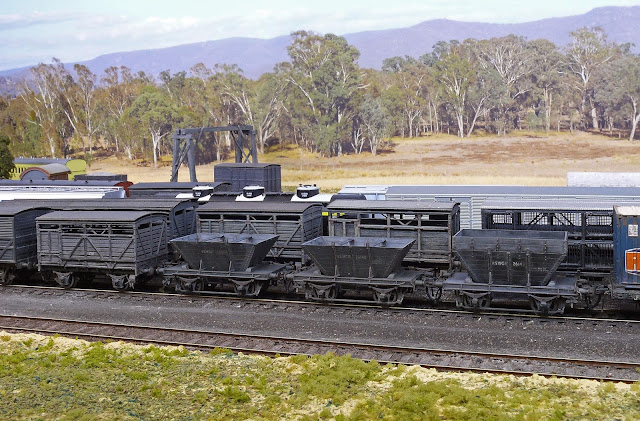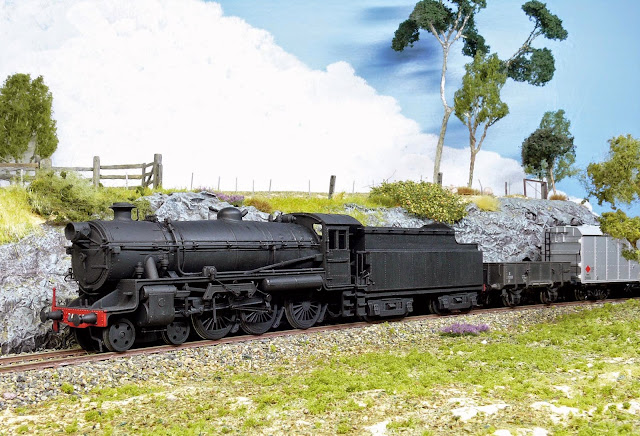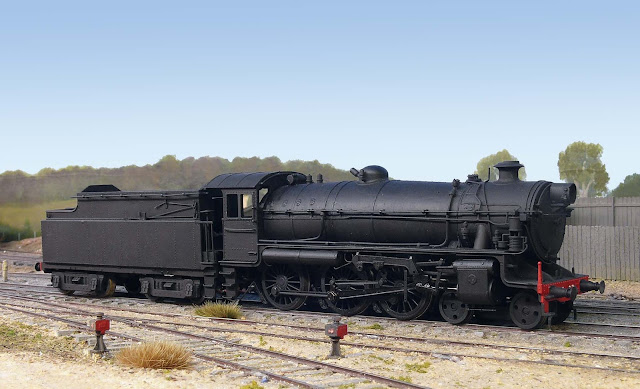The constant deluge of r-t-r rolling stock does make it very easy to fill up the yards with lovely models of the delightfully picturesque wagons that kept the intrastate traffic moving back in the steam/early diesel era in which Lambing Flat is set and quite a few have joined the roster since my last post on the subject some years ago. However, as long term readers will be aware, I don't like things 'straight out of the box'. Before a model will be accepted by the Traffic Officer, Lambing Flat, it has to be weathered, at least! And, while the vast majority of Lambing Flat's new stock is r-t-r, I do occasionally assemble the odd kit or two!
Below are images and brief descriptions of some of the intrastate (ie non-bogie exchange) NSWGR stock that has joined the roster recently.
As with any NSWGR layout set in the wheat growing areas of the state, lots of wheat wagons are essential. I have plenty of four-wheel RU hoppers, courtesy of the old Trax kit and the original Trainorama r-t-r version, but the more modern wheat hoppers have been neglected. A trio of Austrains WHX hoppers were acquired, two as originally delivered and one of the 'Manildra' signwritten models. On the two original condition ones, I replaced the Austrains bogies with the correct type for my period, the 2CE bogies from On Track (and the wheels, as the wheels that come with the On Track bogies are too big). I also altered the wagon number on one of them, as I had somehow managed to acquire two vehicles numbered WHX30756! They were lightly weathered to represent vehicles that have only been in service a short time, as this batch of WHX were delivered in 1971/1973, so fall towards the end of my preferred time period. First I painted the wheels and bogies black, painted the wheel faces Tamiya XF-10 Flat Brown and then 'washed' the bogies with the Flat Brown and Aqueous Hobby Color H343 Soot, I painted the brake hoses and Kadee 'tangs' flat black, then I lightly sprayed the body of the vehicle with a very dilute mix of Isocol alcohol and Tamiya XF-52 Flat Earth. Another light coat of Isocol alcohol and Soot tied it all together. Being very 'modern' wagons by Lambing Flat standards, if they are included in a train, the train is more likely than not to be diesel-hauled!
Up until the release of the Trainorama r-t-r BWH hoppers, there was only one BWH on the layout, an AR Kits kit-built and superdetailed model that I completed in the mid-1980s. A trio of Traino r-t-r BWH hoppers were acquired and weathered back when they came out and, more recently, this Powerline version has also joined the fleet. It is straight out of the box and weathered with my usual acrylic paint technique. I really should have changed the handrails on the foot walk to the correct shape, but I'm not going to live forever... It 'disappears' amongst the considerable number of vehicles that now populate the layout, so, I'm not going to mention it if you don't...
No NSWGR post-war layout would be complete without plenty of these little beauties, the ubiquitous S truck. This is just one of the fifteen Austrains/SDS 'ultimate' S trucks that have joined the many, many kit-built versions of this essential wagon on the layout. This one is from the first Austrains batch, which came painted in a very deep black, so I have weathered it to represent the condition of them when they were relatively new, with a worn interior, but a lightly weathered exterior. In the background is, from the left, an Austrains GSV modified to post-war condition, as per Ian Dunn's article, 'Modernise Your GSV', in AMRM Issue 298 (February 2013), an Austrains '1921' CW and a highly modified Camco '1947' CW kit. Next is the end of an MBC, converted from a very old Rails North epoxy MRC kit.
Here are a few more weathered S trucks from the first 'black' Austrains batch, along with a weathered Austrains CW.
This photo shows a better view of the interiors of two of the S trucks, plus a weathered Austrains SRC refrigerated van and lots of stock wagons from a variety of sources.
And here are a few more, standing in front of some weathered SDS rail tank cars. The COR tank is heavily weathered, but the Golden Fleece version is relatively clean. Believe it or not, the photos of Golden Fleece RTCs I have seen that were taken in the 1960s show them quite clean and bright.
The second batch of Austrains S trucks came with a much greyer paint finish, so that has been utilised to represent S trucks that have been in service longer than those represented by the weathering done on the first batch. Also shown here is a Trainorama K wagon which was weathered at the same time, using my usual acrylic paint technique. Surrounding the newly weathered vehicles are some of the many open wagons on the layout, including r-t-r Traino steel S trucks, kit-built ILM D and BD, plus Trax/Casula S and K wagons and a very old Bergs K wagon (with Dreadnought ends).
Another Austrains S from the second batch, along with a Eureka RSH and Traino K wagon, with Austrains PV explosives van and MV louvred van, all weathered with my acrylic paint and Isocol alcohol method.
An Austrains '1921' CW, plus two Eureka LCH and a CCH four-wheel hopper wagons, stand in front of a rake of stock wagons, including an Austrains '1915' CW and a Silvermaz '1948' CW, heavily modified and backdated to their appearance on delivery, before the extra vertical strengthening timbers were added to the sides.
I'll finish off tonight's post with a couple of stock wagons, starting with this SDS BCW. This has had a canvas (stretched tissue) roof covering added, but otherwise is 'straight out of the box'. It is is pretty good condition, just a little grubby, which is appropriate for Lambing Flat's time period, as these vehicles were introduced in 1959, so were quite new at the time the layout represents. Weathered with my usual 'misted' acrylic techniques.
There are two '1959' BCW bogie cattle wagons on the layout, the modern SDS version shown above and this old Protype kit, constructed back in the early 1980s. Not knowing any better at the time, I had constructed it with a double roof, as per the four-wheelers. I recently took the double roof off and fitted a new canvas covered single roof, as it should be. The new roof was painted and weathered and the body reweathered to blend it all together. Not up to the standard of the SDS version, but not bad for a model for which the masters were constructed in the late 1960s...
A definite relict of the past, an Austrains '1915' CW. While most of these were 'converted' to the '1921' CW specifications during the 1930s and 1940s, at least two soldiered on until 1965/'66! (I've seen them in a video taken at Nyngan.) Weathered with the usual acrylics method.
Last, but not least, is the last of my Austrains GSV sheep wagons to be weathered. It had taken so long (the rest were finished years ago) because I didn't have a replacement GSV roof for this one (they were mistakenly fitted with CW roofs at the factory). I obtained replacement roofs from Austrains for the rest of them, but not for this one, for some reason lost in the depths of time! So, I finally got around to scratchbuilding a new roof (and modifying the model to represent the post-WW2 appearance of the '1927' GSVs, as per Ian Dunn's article 'Modernise your GSV' in AMRM Issue 298 (February 2013). It's late completion also means that it is the only loaded sheep van on the layout, as it has been fitted with some of Ray Pilgrim's 3D printed sheep. The roof was completed very conventionally with strips of timber and styrene, with corrugated aluminium for the roof itself. Weathering was by my standard Acrylic paint method, with a combination of washes and drybrushing to get the base elements, with the whole thing then airbrushed with light coats of 'misted' colour to tie it all together.
There are still quite a few to describe, but that will have to be in a future post...




















